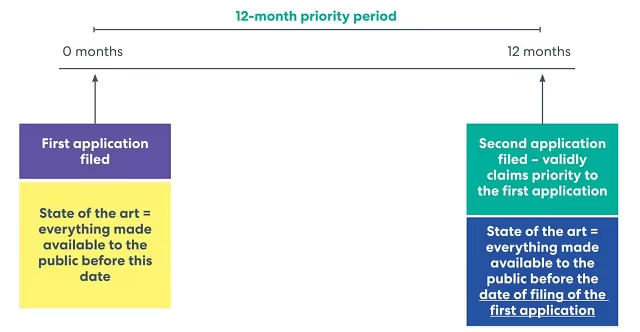
Project Management Tools for R&D: The Essential Software Stack for Research-Driven Teams in 2026


In the world of patents, understanding the concept of priority date patent is crucial for R&D Managers, Engineers, and other key personnel/departments within the company. The priority date serves as a critical milestone in securing your invention’s protection and plays an essential role in determining its validity.
Throughout this blog post, we will delve into various aspects related to priority date patent such as establishing inventorship through priority dates and their impact on foreign and PCT applications. Furthermore, we’ll discuss provisional patent applications’ significance in claiming early filing dates while converting them into non-provisional patents.
You’ll also gain insights on how to claim priority over earlier filed patents by understanding independent conception scenarios and winning rights through the earliest established dates. We will emphasize specific reference documentation required for determining validity along with consequences arising from insufficient evidence.
Last but not least, we’ll analyze a real-life case study – Honeywell International vs Arkema Inc., which highlights key issues raised concerning priority date patent disputes and valuable lessons learned from it that can be applied to your own intellectual property endeavors.
Table of Contents
The priority date is a critical aspect of the patent application process, as it establishes who the first inventor was and affects deadlines for filing foreign applications and international PCT applications. In situations with only one patent application, the priority date is typically the same as its filing date; however, this can change if an applicant files a provisional patent application or claims priority over other earlier filed patents.
A well-defined priority date patent helps establish inventorship, ensuring that rightful inventors receive credit for their work. The earliest filing date determines which invention will be considered prior art against other related patent applications. This means that any subsequent inventions disclosed after this established earliest date may not be granted protection if they are deemed too similar to existing patented technology.

Understanding the importance of priority dates in patent applications is essential for R&D managers, product development engineers, and innovation teams. By securing an early filing date and effectively managing related applications, inventors can safeguard their intellectual property rights while navigating complex international patent landscapes.
Key Takeaway:
The priority date patent is crucial as it establishes the first inventor and affects deadlines for filing foreign and international PCT applications. A well-defined priority date helps establish inventorship, ensuring rightful inventors receive credit for their work while securing an early filing date to safeguard intellectual property rights in complex international patent landscapes.
Filing a provisional patent application allows inventors to secure an early priority date while they finalize their invention details. This strategy can be advantageous for R&D Managers, Product Dev Engineers, and Scientists who are still refining their innovations or seeking funding before committing to the more expensive nonprovisional patent application process.
To claim a specific priority date based on a provisional application, an inventor must file a complete description detailing how to make and use their invention within 12 months from when they initially filed any related applications. The subsequent nonprovisional patent application should include all necessary information about the claimed subject matter as well as a reference back to the earlier-filed provisional document.
It is essential to ensure that the nonprovisional application adequately supports the invention described in the provisional filing. Failure to do so may result in an effective filing date later than expected, potentially exposing your innovation to additional prior art and jeopardizing your patent rights.
Key Takeaway:
Filing a provisional patent application can help R&D teams establish an early priority date, allowing them to secure their place in line at the patent office. This strategy is advantageous for innovators who are still refining their inventions or seeking funding before committing to the more expensive nonprovisional patent application process. However, it’s important to ensure that the subsequent nonprovisional application adequately supports the invention described in the provisional filing to avoid jeopardizing your patent rights.
In the fiercely competitive landscape of patent filings, it is essential for creators to ensure they secure their priority date in a timely manner. This becomes especially important when two inventors independently conceive of the same invention. In such scenarios, the Patent Office awards rights based on the earliest established priority date.
When multiple parties develop similar inventions without knowledge of each other’s work, they may end up filing separate patent applications. The first-to-file system in most countries means that whoever has the earliest priority date will be granted exclusive rights to their invention.
For example, if Inventor A files a provisional application on January 1st and later converts it into a nonprovisional application by December 31st with no changes made during this period while Inventor B submits an identical idea directly through nonprovisional channels just one day after initial submission (January 2nd), then A would still hold precedence over B due solely because they claimed proper priorities at time-of-filing itself.
Claiming priority over earlier filed patents is a critical component of patent protection, as it can determine the validity and enforceability of an invention. Therefore, proper documentation and evidence are essential in order to secure rights through the earliest established dates.
Key Takeaway:
To secure exclusive rights to their invention, inventors must establish their priority date as early as possible and file a provisional or nonprovisional patent application. Keeping detailed records of all stages in developing the innovation and regularly reviewing patent databases can help establish a claim to the earliest possible priority date. In short, claiming correct priorities during initial filings is essential for success in the competitive patent landscape.
The importance of establishing a valid priority date cannot be overstated, as it plays a crucial role in determining the rights to an invention. A recent Federal Circuit decision emphasizes that “specific reference” is key to determining which party’s claimed dates are valid for establishing precedence on particular inventions.
Without proper documentation supporting these assertions during prosecution stages, applicants may lose out due to insufficient evidence backing up their arguments about prior art history status – even if they have otherwise met legal requirements set forth by governing bodies like USPTO regulations concerning such matters.
To ensure your patent application stands strong against potential challenges and disputes over priority dates, it is essential to provide accurate and complete documentation throughout the entire process. This includes submitting all necessary citations related to earlier filed patents or applications that you wish to claim priority from. Failure to do so can lead not only to losing the earliest filing date but also potentially invalidating your entire patent application.
By paying close attention to the documentation and specific references required when claiming priority over earlier filed patents, you can ensure that your patent application has a solid foundation and stands up against potential challenges in the future.
Key Takeaway:
Establishing a valid priority date is crucial in determining the rights to an invention, and specific reference plays a key role. Proper documentation throughout the entire process is essential to ensure your patent application stands strong against potential challenges and disputes over priority dates, as insufficient evidence can lead to losing foreign filing rights or weakening enforceability during litigation or licensing negotiations.
The Federal Circuit Court of Appeals addressed issues surrounding asserting correct priorities when filing initial applications themselves in the case Honeywell International vs Arkema Inc.
This case highlights the importance of properly establishing priority dates and serves as a reminder for inventors to pay close attention to their patent application process, ensuring they meet all legal requirements and provide the necessary documentation.
Honeywell filed a series of related patent applications claiming multiple priority dates based on earlier filings, including provisional and nonprovisional patent applications.
In response, Arkema argued that some claims were not entitled to their claimed priority dates because they lacked specific reference to the subject matter disclosed in earlier-filed applications or failed to satisfy other legal requirements such as written description support or enablement criteria under USPTO regulations.
The Federal Circuit ultimately agreed with Arkema’s arguments, finding that certain claims were not entitled to their asserted earliest date due to insufficient evidence supporting these assertions during prosecution stages (such as missing citations).
Key Takeaway:
The Honeywell International vs Arkema Inc. case highlights the importance of establishing priority dates correctly and meeting all legal requirements when filing patent applications. Meticulous record-keeping, specific referencing, and compliance with USPTO regulations are crucial to avoid disputes over precedence in inventions against competing parties seeking similar protections through patent office channels.
In conclusion, the priority date patent is crucial as it establishes inventorship and impacts foreign and PCT applications. Filing provisional patents can provide benefits, and claiming priority over earlier filed patents can win rights through the earliest established dates. Proper documentation is important for a specific reference in determining validity, as insufficient evidence can have consequences.
Overall, understanding the importance of priority dates in patent applications is essential for R&D Managers, Engineers, and other key personnel/departments within the company.
If you need help with your patent application process or want to learn more about prioritizing your intellectual property strategy, contact Cypris. Our platform provides rapid time-to-insights, centralizing data sources for improved R&D and innovation team performance.